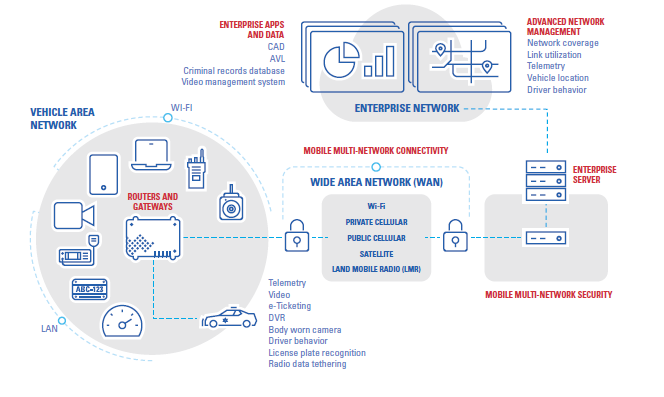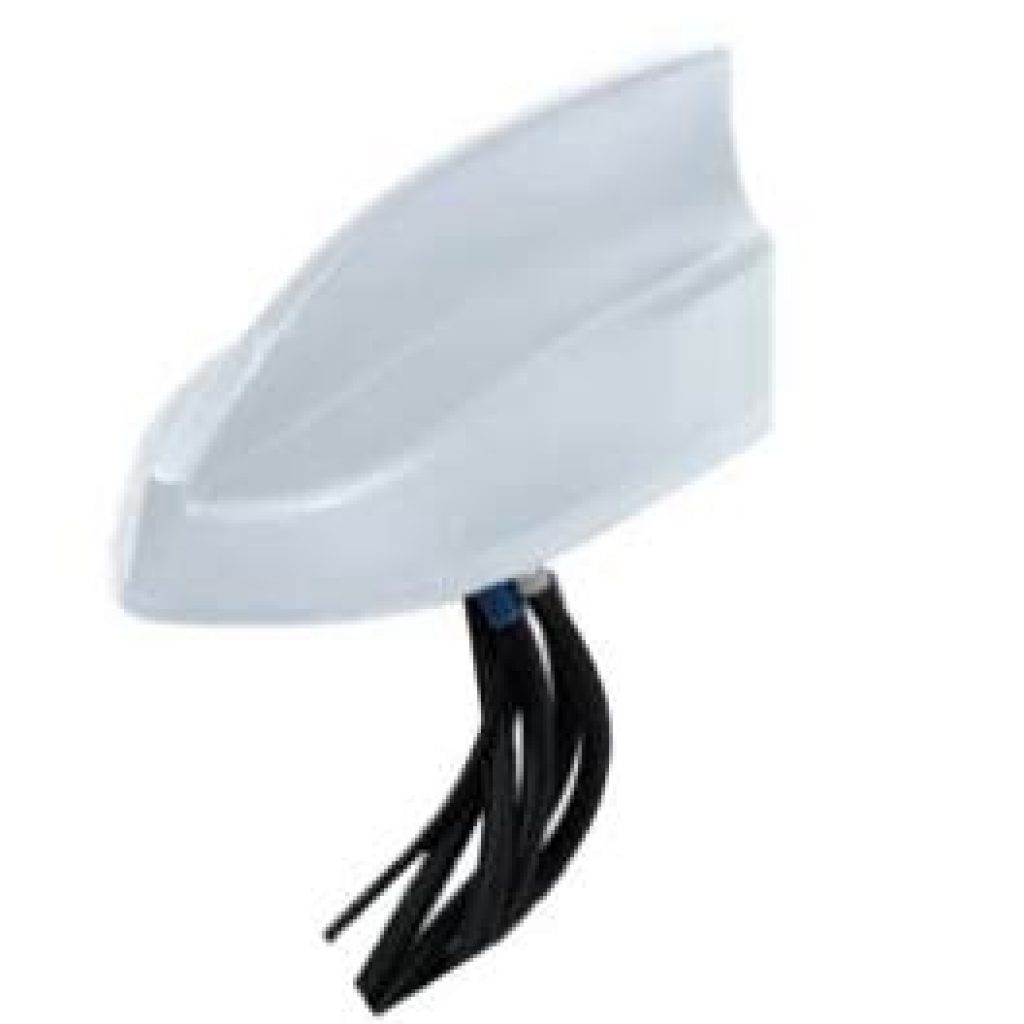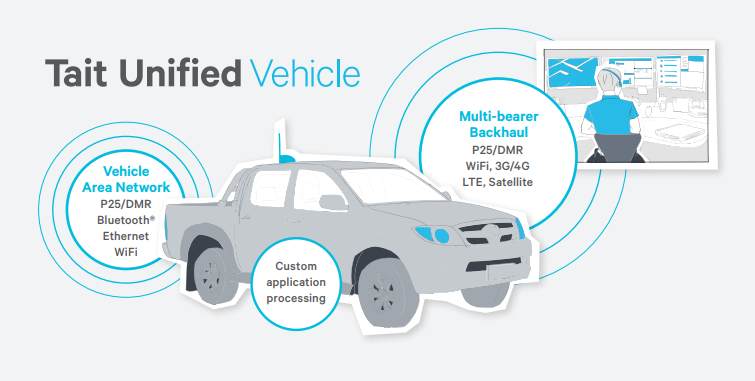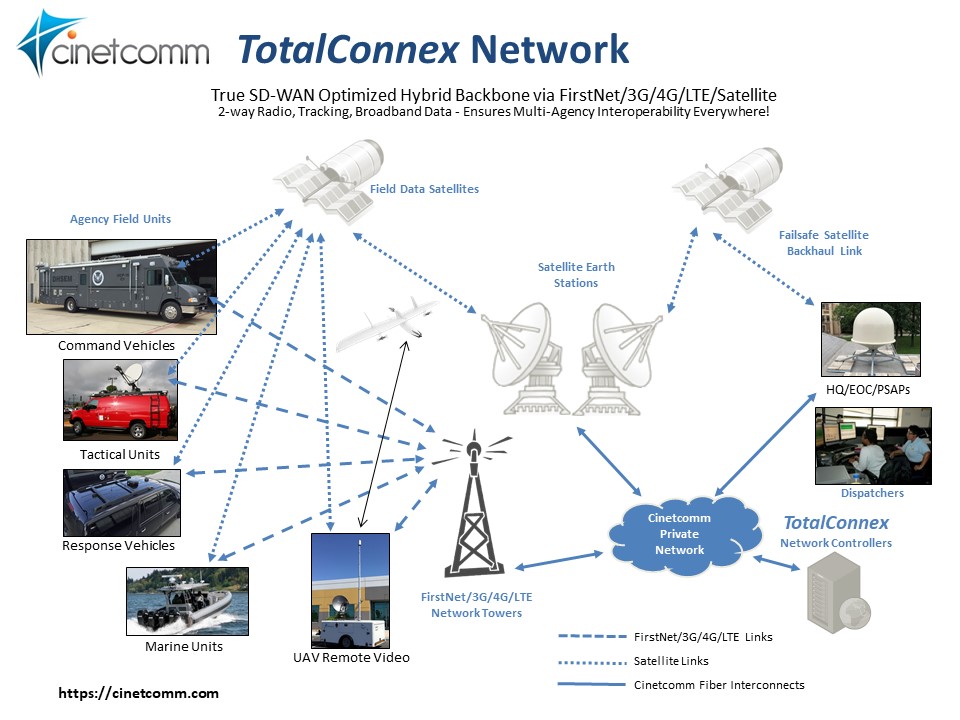“Vehicular communications hubs” are a logical combination of communications resources into multi-function communications devices. This is a natural progression for public-safety and critical-communications systems that is becoming a focal point for public-safety communications.
It is always interesting to observe how things are improved over the years to provide better features and functions. The vehicular hub is a good example. In the late 1970s and early 1990s when I worked for Motorola in the Los Angeles area, the LA County Sheriff and the Phoenix Fire Department began introducing mobile data terminals made by MDI in Canada. MDI’s terminals employed some of the same Land Mobile Radio (LMR) channels as Push-To-Talk (PTT) voice systems, either as dedicated data channels or shared voice/data channels.
To say data was sent and received at a slow speed would be an understatement. As these terminals were being installed, we advised the deputies that when they requested a license check using the terminal, they should go have a cup of coffee and the response to their query would arrive by the time they returned. During the 1970s and into the 1980s, Motorola offered other forms of data devices that could be put into service. These systems used existing radio channels without a lot of bandwidth.
Another form of an early hub was the addition, again led by Motorola, of what is still referred to as a “pack-rat” (officially, a PAC-RT), which is a secondary LMR radio transmitter and receiver mounted in the vehicle and interconnected with the standard mobile radio. It is still used by many departments since it enables a handheld radio within range of the vehicle to transmit and receive only to the vehicle, and then uses the vehicle’s higher-power radio with much better range as a relay station for the handheld.
Fast-Forward to Today
Today, we have new breeds of vehicular communications systems. For this Advocate, I have divided the devices into three groups:
- Broadband routers
- Land mobile radios with build-in broadband, WiFi, Global Positioning System (GPS), and more
- Devices that bring LMR and broadband systems together. A backhaul link to keep the radios in the vehicle connected to their terrestrial networks is provided by a satellite antenna mounted on the vehicle. When terrestrial networks are not available, the satellite system usually will be.
These three types of devices are now considered to be vehicular communications hubs. Much of the activity in this category is intended to simplify the number of communications devices mounted in a vehicle, reduce the number of microphones and interconnections, and at the same time bring the capabilities of both LMR and broadband services to and around the vehicle in the form of a communications bubble that can be accessed by first responders within line-of-sight and several hundred yards.
As vehicles have been equipped with communications, sirens, lights, video cameras, and much more, the front passenger seat has often become unusable for a second person. The cost of what is installed in a vehicle can sometimes rival the cost of the vehicle. I believe we are seeing more and different types of vehicle hubs since we now know we will continue to need a minimum of two different types of radio systems. Before FirstNet, broadband was the new normal and it was being used primarily for mobile data terminals and laptops or tablets mounted in vehicles, with LMR being the most-used form of communications to and from the vehicle. Today, one would be hard pressed to find a public-safety agency where both LMR and broadband are not important elements in their communications strategy.
FirstNet changed the dynamic for what broadband brings to first responders. Broadband is now used for video up and down links and dial-up and push-to-talk voice in addition to mobile laptop and tablet connections. Tighter integration of communications in vehicles should help bring down costs and take up less room. Once broadband is part of the master plan, the concept of the connected vehicle becomes a reality. For example, today, typical paramedic rigs use multiple broadband connections for a variety of medical devices so they can share real-time information with a hospital.
Having set the stage, let’s look at the current three classes of product offerings.
Mobile Wireless Broadband Routers
The first mobile routers were designed solely for broadband services. Vendors of vehicle-mounted radios now offer multi-purpose devices as well. Multi-purpose devices provide access to broadband services in vehicles, and many are capable of providing a WiFi bubble and perhaps a Bluetooth bubble around the vehicle. They may include broadband wireless from one or more network provider, WiFi, Bluetooth, GPS, and other features applicable for in-vehicle and near-vehicle communications. Perhaps the most connected mobile routers are those installed in EMS/paramedic vehicles that need to connect to a variety of medical devices including those for EKG transmission, and perhaps transmitting ultrasound and other images from the rig to the hospital.
Several vendors sell these routers today and the two largest, by far, are Cradlepoint (now owned by Ericsson) and Sierra Wireless. Others include Pepwave, and a few others. If you plan to use one of these routers on FirstNet, make sure it has been approved by FirstNet (Built with AT&T) for use on the network as not all routers in a vendor’s product line are necessarily certified. A typical router can be configured for one, two, or even four broadband systems, each requiring SIMs for different broadband networks.

Typically, a router installed in a public-safety vehicle can be used to provide broadband to tablets or laptops in the vehicle and to support other devices via WiFi and Bluetooth in and around the vehicle. Some routers are also connected to other vehicle devices such as engine diagnostics and perhaps a shotgun mount that sends a signal when the weapon is removed. They are often connected to on-dash cameras and, of course, on-person cameras via WiFi.
These routers are generally connected within “shark fin” antennas that include antennas for broadband, WiFi, Bluetooth, and GPS a single housing. Mobile routers are usually added to public-safety vehicles that already have LMR radios.

Routers that add 5G services to LTE broadband systems are already on the market. Because 5G systems are spread out over many different portions of radio spectrum, it will be important to make sure the router and antenna are matched for 5G services that are available or are coming soon to your area.
Many mobile routers also provide real-time information about the vehicle’s location and strength of the broadband signal being received and sent. In many cases, all this data is collected in the cloud so there is a tracking history and this data is also useful when checking the coverage of various broadband systems.
When choosing the router path, you will need to determine if you want to use one broadband network (e.g., FirstNet) or if you want to add a second network. In this case, you can probably contract with FirstNet and then purchase data by the kilobit from a secondary broadband network operator.
High-Power User Equipment (HPUE) can be easily added to most FirstNet-approved routers to extend coverage and improve data throughput. HPUE devices are available from at least two vendors in several different form factors. With HPUE devices, FirstNet Band 14 users can increase the transmit power level of a router or other FirstNet device from 0.25 watts to 1.25 watts. Early tests indicate this increase in power can add up to 80-percent more coverage of an existing cell site and maintain much higher data rates farther from the cell center.


LMR/Broadband Radio Combinations
These new combination LMR/LTE devices are now the “in thing.” In 2012 soon after FirstNet was created, we had two contracts to provide ideas for LMR vendors about how LMR and LTE would come together and how an LMR vendor might want to look at product development. One report included the following statement (NDA has expired):
“The roadmap for devices will move rapidly through several generations. The Public Safety community will move quickly from vehicle-mounted modems connected to existing or new laptops, to handheld LTE-only devices to augment existing LMR voice radios. These might include some Wi-Fi-based devices with Wi-Fi hotspots installed in emergency vehicles and they will be followed by devices that will marry LTE and LMR services into a single mobile and then handheld device. While there are those, including the PSCR program and NTIA that believe that Voice over LTE (VoLTE) will be capable of both mission-critical performance and off-network communications in the 2015 timeframe, ASI’s projection is that before agencies can consider abandoning their LMR systems in favor of Voice over LTE, it will more likely be in the 2020 and beyond timeframe.”
The final recommendation for this vendor, which it decided was premature, was to provide a slot for an LTE module in all mobile radios. At that time, these modules were being produced by several vendors in a form factor that fit into traditional laptop computers. As far as I know, Panasonic was the first company to include LTE in its laptops (Toughbooks).
Times have changed. At that point, FirstNet was being formed, the board of directors had yet to be named, and we could not even guess as to when the network would be up and running. Today, FirstNet has proven the need for a nationwide public-safety broadband network, other broadband vendors are trying to compete with FirstNet, and guess what? Mission-Critical Push-To-Talk (MCPTT) is only beginning to take shape and there is still no sound LTE off-network technology that will meet public-safety’s requirements. The demand for new types of radios and command-and-control of all things public-safety communications has reached the point where it makes sense to combine technologies into a single, easy-to-install device that will quickly become the focal point of communications in and around vehicles.
As more and more agencies add broadband technology to their existing LMR systems, vendors have begun to produce multi-purpose mobile radio systems that include LMR sub-systems, broadband, and other sub-systems built on a common chassis that requires only a single installation to provide both LMR and broadband capabilities along with typical GPS, WiFi, and Bluetooth capabilities.
Like handheld combination devices before them, the mobiles coming online include both LMR and broadband capabilities over multiple LMR bands (usually 150/450/700/800 MHz) and then one or two LTE radios. Again, LTE radios must be approved by FirstNet (Built with AT&T) if they are to be used on the FirstNet network. Now some companies have decided to provide single-band LMR/LTE routers in addition to multi-band LMR/LTE mobile routers. Obviously, these single-band units bring down the cost of the hybrid devices.
L3Harris XL-200M / XL-185M
L3Harris appears to be the leader in this category of products. Its XL-200M is a multi-band LMR with up to two LTE radios in one device. Unlike any other multi-band LMR radio I have seen so far, the L3Harris includes the 900-MHz band because that is where many of its industrial critical-communications systems reside. The radio is designed to be a complete under-dash mount unit or it can be remotely mounted in the rear of a vehicle with the control head mounted in the dash. Having installed several hundred radios in public-safety vehicles in an earlier life, I love the fact that the cable between the radio and the control head is a single Ethernet cable like the ones used to connect PCs and notebooks to a wired network. Along with the XL-200M multiband radio, L3Harris is also offering the XL-185M, which is a single LMR band plus LTE version of the XL-200M.
The company recently announced the addition of its L3Harris Device Management set of tools, which is a cloud-based system for programming both mobile and multi-band handhelds (XL-200P and XL-185P) anywhere they happen to be. Unlike other cloud systems, the fleet operator has full control over all aspects of the radios in the field and goes well beyond other Over The Air Re-keying (OTAR) systems by providing capabilities for managing an entire fleet of L3Harris devices. I plan to take a deeper look at this method of fleet management as well as others in a future Advocate after I have seen some real-world demonstrations.
Tait Unified Vehicle System
Tait Communications has chosen a different name for a hub and a different way of looking at requirements for vehicular communications. Its “Unified Vehicle” system is explained as follows:
“Tait Unified Vehicle is a multi-bearer communications hub, offering a high level of connectivity, with access to LMR, cellular and WiFi. It’s the flexible communications core to integrate and customize solutions for your organization’s needs.”

Tait turned this concept into a product that features an “easy-to-integrate, single device solution with a familiar form factor.” With this different approach to the hub category, Tait has developed a system that includes an AppBuilder that enables systems integrators to design all aspects needed to control radio functions and connectivity. AppBuilder appears to be a “build it as you need it” type of system with all the radio functionality you would expect: LMR, broadband, WiFi, Bluetooth, and GPS. You can add Tait’s PTToX service that delivers the ability to stay connected. For example, if you run out of LMR network coverage, the LTE system will pick up the communications and basically extend the range of existing LMR systems over LTE.
There appear to be many ways to deploy Tait’s Unified Vehicle system. Tait’s literature on the products identifies key features as follows:
- Powerful applications platform
- P25 and DMR mobiles supported
- 3G/LTE cellular connectivity with dual-SIM capability
- Broadband connectivity options and sharing (tethering)
- Create a network of networks
- Improved voice and data support
- Embedded applications include
- PTToX (Push-To-Talk over X) LMR, WiFi, cellular, and Ethernet, where selection can be manual or automatic (configurable priority)
- GeoFenced
- AppBuilder
- Over-The-Air Programming (OTAP) over WiFi and cellular networks – voice recorder
- Multiple bands, regions, and carrier approval
It appears Tait is taking the approach that many systems will require different types of features and functions and it has designed this system to be as flexible as possible. I think Tait will also offer satellite backhaul in the future, which brings me to the final category
Never-Out-of-Coverage Vehicle Hubs
The title of this section may be somewhat inflated, but the point is that several companies looking at the convergence of LMR/LTE systems have added yet another aspect, which is to include a mobile satellite antenna and system in the vehicle. The goal is to be able to remain in contact with both the LMR and LTE network even when the terrestrial networks are left behind or they fail.
A number of companies provide similar “all-the-time coverage.” Some claim to be able to provide a total access set of solutions and I will be spending time on two of them in this Advocate.
The first company is Cinetcomm and its website introduction says it provides satellite and wireless communications. In reality, Cinetcomm has been able to combine an existing LMR radio and an LTE router, and it’s Pepwave is FirstNet-certified. Cinetcomm’s products and services can be connected to any existing LMR radio (Analog, P25, P25 Trunked, DMR) and the router using an integrated control head and back-end system. The result is that the existing LMR device and one, two, three, or even four broadband networks are all interfaced with the console that becomes the distribution point for both LMR and LTE traffic. If users run out of LMR coverage, the system will switch the LMR device to use the LTE radio if it is in range. If not, it will switch to the satellite for backhaul. The same is true for the LTE device.

In all instances, mobile hub users may not even know they have been switched to a different form of backhaul since the system operates on its own and selects the backhaul route depending on the signal levels on the network(s). In addition to the vehicular hub, Cinetcomm provides the same level of connectivity at emergency-communications centers and to communications vans that are used during ongoing incidents.
Kymeta
Kymeta recently announced commercial availability of its next-generation antenna, terminal, and services designed for those serving critical-communications systems. A statement in its press release provides a good description of what this new offering includes:
“The Kymeta u8 covers the full Ku-band and is designed to be LEO upgradeable. The u8 is available as an antenna, an ODU (with no modem), and a turnkey terminal with embedded satellite modem, cellular modem, and SD-WAN capabilities. The Kymeta terminals are easy to set up and they acquire service within minutes of being powered. Also coming soon is a transportable configuration called the u8 GO, which is ideal for rapid deployments. The u8 GO will enable safe transport with a hardened case for protection and provides a built-in car mount to support easy operations on the pause and on the move.”
While discussing this new set of product offerings, a company representative told us that in addition to being able to use broadband services via its mobile satellite system when the vehicle is out of range, the system is flexible enough to also handle LMR systems via the satellite backhaul when the vehicle is out of LMR range. Kymeta is marketing its products and satellite access as a service for customers that want to ensure their vehicles continue to have connectivity even when out of range of terrestrial networks.
Conclusions
It is clear to me that we are heading toward a public-safety communications scenario that includes broadband Next-Generation 9-1-1 (NG911) for incoming voice, text, data, photo, and video requests for service. After the professionals at the Emergency Communications Centers vet the information, it will be sent on to responders from the appropriate agencies. Field communications requirements will continue to include land mobile radio systems as well as the FirstNet broadband system. It has only been a short time since the contract to build and operate the FirstNet network was awarded. When you map that timeframe to the number of device advances that have been made, it becomes clear vehicular communications hubs will remain one of the most important pieces of the communications solution.
I am certain there will be more mobile hubs entering the market and there will be refinements to those already on the market. We have already seen several vendors introduce combination 5G/LTE routers, and I believe the other two categories of vehicular hubs will follow in short order. As LMR equipment is replaced, more first-responder vehicles will be equipped with hub devices, and you can be assured even more connectivity and capabilities will be added to make first-responders’ jobs easier and safer.
Correction, “Z-Axis Location,” December 3, 2020
The folks at NextNav have informed me that the FCC’s location requirement is within three meters 80-percent of the time. NextNav exceeds this standard by providing location information within three meters or less 94-percent of the time. Further, its Pinnacle technology behind the z-axis uses a software application and does not require a new chip while TerraPoint, NextNav’s Position, Navigation, and Timing (PNT) product, still requires an embedded chip.
Until next week…
Andrew M. Seybold
©2020, Andrew Seybold, Inc.


Be the first to comment on "Public Safety Advocate: Vehicles as Communications Hubs, Z-Axis Correction"